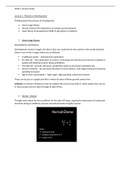Week 2 Lecture notes:
Lecture 1: Theories of Development
Thinking about the process of development:
1. Linear stage theory
2. Harrod- Domar (The importance of savings and investment)
3. Lewis theory of development (Shift of agriculture to industry)
1. Linear stage theory:
Developed by walt Rostow
Development comes in stages, the idea is that you could look at any country in the world and place
them in one of the 5 stages which are as followed:
Traditional society – dominated by agriculture
Pre take-off – how application of science, technology and infrastructure become available to
people with banking systems being established
The take-off – growth rates grow, production systems are greater and better pay
Drive to maturity – the economy becomes far more diverse, with wages rising and consumer
spending increased
Age of mass consumption – high wages, high spending, advanced economy
These can be put on a graph and this is where the idea of linear growth comes from
Criticism: A criticism of Rostow is that he explains the process but doesn’t really explain how you do
it, how you go from pre take-off stage to take-off etc.
2. Harrod – Domar
Thought more about the key conditions for the take-off stage, arguing the importance of saving and
how that saving is mobilised, assumes investment leads to higher income
, Week 2 Lecture notes:
It means the rate of change/income otherwise
known as economic growth is equal to savings as
a proportion of capital stock (The amount of
capital available, present & the level of nations
savings).
Harrod-Domar are saying GDP growth is related
directly to the nations saving and the amount of
capital it has
Example of how to use equation:
The implication is for poor countries that tend to have low capital, if they can have high saving rates
they should be able to grow quickly
Growth is higher when savings are high and capital stock is low
As capital stock rises, growth becomes harder
A poor country should be able to grow quickly when it has low stock of capital and high
savings because the initial return on investment is very high
The obvious problem here is what if the poor country doesn’t have any savings? What can policy
makers do to help develop higher rates of savings, is there anything about the institutional or
cultural conditions that may not be adequate to utilise savings (poor banking systems etc)
3. Arthur Lewis and theory of development
Talks about structural change, how nations change structurally from agriculture to industry (ever
developed country has gone through this stage)
Duel sector model (agri/industry)
Explains growth in terms of labour shift from farming, rural economy to industry
In the rural economy there is a surplus of labour, meaning there is labour with not enough to do in
the countryside, so the labour has to go somewhere. As the industrial sectors expands it will attract




